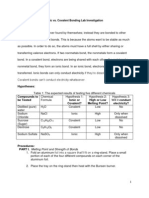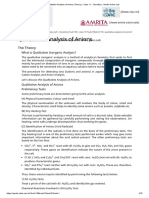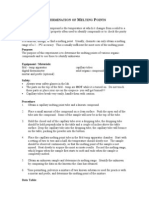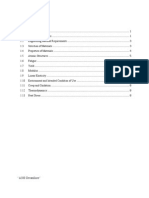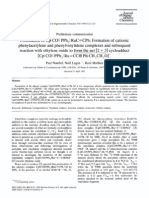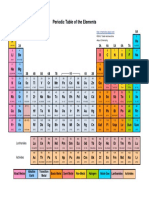At a glance
Powered by AI
Flame tests can be used to identify metal ions based on the distinct color they produce when heated in a flame. The color is due to the metal ions entering an excited state and emitting photons of specific wavelengths as they fall back down to the ground state.
NAME
: Anna .T. Ramgulam
I.D #
: 00039038
CLASS
: CHEM 131
–
General Chemistry I
CRN
: 12560
CLASS LECTURER
: Ms. Risha Kalloo
LAB LECTURER
: Mr. Bisram Ramdatt
LAB
: TWO (2)
TITLE
:
FLAME TESTS
–
EMISSION SPECTROSCOPY
INTRODUCTION
AIM
: 1. To investigate and predict the identity of metal ions, Li
+
, Na
+
, K
+
, Ca
2+
, Ba
2+
, Cu
2+
with the use of flame tests.2. To determine the cations in each of the two unknown substance by observingthe flame colour of different metal compounds.
BACKGROUND
:A number of common metal ions, (Li
+
, Na
+
, K
+
, Ca
2+
, Ba
2+
, and Cu
2+
) give a distinct colour inthe presence of a flame. Therefore, a flame test is often used as a confirmatory test in identifyingan unknown metal. Compounds of these ions provide the beautiful colours in a fireworks display.When glass is melted in a Bunsen burner flame, sodium ions colour the flame bright yellow. Acopper wire inserted into the flame often results in a striking deep blue or green colour.
THEORY
:According to the Bohr Theory of the atom, electrons may occupy only specific energy levels.
When an atom absorbs sufficient energy, an electron can “jump” to a higher energy level. Higher
energy levels tend to be less stable, however, and if a lower energy level is available, the electron
will “fall” back, giving off energy in the process. The difference in energies between the two
levels is emitted in the form of a photon of electromagnetic radiation. The energy of each photonis described by the equation
E = hv, where h is Planck‟s constant and v is the frequency of the
radiation. If the wavelength of the released photon is between 400 and 700 nm, the energy isemitted as visible light. The colour of the light depends on the specific energy change that istaking place. White light is a continuous spectrum in which all wavelengths of visible light arepresent. An excited atom, however, produces one or more specific lines in its spectrum,corresponding to the specific changes in energy levels of its electrons. Because each element hasa distinct electron configuration, each has a unique line spectrum.Flame tests are a quick method of producing the characteristics colours of metallic ions. Theloosely-held electrons of a metal are easily excited in the flame of a lab burner. The emission of energy in the visible portion of the spectrum as those electrons return to lower energy levelsproduces a coloured flame. The colour is a combination of the wavelengths of each transition,and may be used to determine the identity of the ion. If two metals are present in a mixture, thecolour of one flame may obscure or hide that of the other. However, if cobalt glass is used, it ispossible to absorb one of the colours and not the other. Therefore we will also look at a flameproduced from a mixture of compounds. From the data, we will then be able to identify whichmetals are in the unknown substance based on what colour flame it produces upon heating.
MATERIALS AND METHODS
APPARATUS & MATERIALS
:Bunsen burner NaCl(s) 0.5M ZnSO
2
(aq)11 beakers 0.5M NaCl (aq) 0.5M Ba(NO
3
)
2
(aq)10 test tubes 0.5M LiNO
3
(aq) 0.5M KNO
3
(aq)Nichrome wire Na and K mixture Test tube with 7.0M HClUnknown metal 1 & 2 Micro test tube PbNO
3
(aq)
METHOD
:
PART A: Known Cations
Each test tube (not the test tube containing the 7.0M HCl) was filled to a depth of 1cm with theirrespective stock solutions. The Bunsen burner was then ignited and the flame was adjusted toproduce a non-luminous (smokeless blue flame with a pale blue inner core) flame. The nichromewire was then cleaned by dipping it into the test tube containing the 7.0M HCl and then held inthe hottest part of the flame. This was repeated until the wire imparted no colour to the flame.The loop of the clean nichrome wire was then inserted into the test tube containing the solutionand held in the hottest part of the flame. The wire was then cleaned as instructed before and theflame test was repeated for each solution. The colour of the flame for each of the cation was thenrecorded in a Data Table. The flame test was then repeated for Na
+
ions using a little dry sodiumchloride and the results were recorded as well.
PART B: Unknown Cations
The nichrome wire was cleaned and the flame test was done on the two unknown solutions. Thesolutions were also retested to ensure accuracy when identifying them. The results were thenrecorded on the Data Table as well.
PART C:
Solutions containing ≥1 Cation
The nichrome wire was cleaned again and the flame test was carried out on the solutioncontaining the mixture of the KNO
3
and NaNO
3
. The results were then recorded in the DataTable.
PRECAUTIONS
:
Safety
:1)
Proper care was taken when handling the HCl to prevent injury as it is caustic andcorrosive.2)
Proper care was taken when rinsing out the test tubes containing the acid, as adding waterto acid will result in an explosion.
Efficiency
:1)
Each flame colour emitted was observed thoroughly to ensure accuracy2)
Each flame test were repeated to ensure precise and efficient results
RESULTS
:The following data table shows the results that were obtained in this experiment:



















